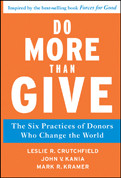
Do More Than Give: The Six Practices of Donors Who Change the World
Leslie R. Crutchfield, John V. Kania, & Mark R. Kramer
250 pages, Jossey-Bass, 2011
The paradox at the heart of being an effective philanthropist is that it is not all about the money. Having a dollop of cash to give away gets you into the philanthropy business, but it has surprisingly little to do with whether you make a success of it. This is what Warren Buffett was getting at when he said, “It is far easier to make money than to give it away effectively.” Bill Gates reinforced the point when he told me, during my research for Philanthrocapitalism, that his foundation, the biggest the world has ever seen, is a “tiny, tiny organization”—his point being that despite all his and Buffett’s billions, the Bill & Melinda Gates Foundation cannot achieve its ambitious goals unless it leverages far larger resources and organizations to help.
How to turn philanthropic dollars into significant impact, even if you have far less to give away than Gates, is the subject of this excellent new book by Leslie Crutchfield, John Kania, and Mark Kramer. Their first point is that change requires serious commitment, and although they do not advocate putting all your eggs in one basket—a portfolio of causes is okay—they argue that nothing can be achieved without focus. Who can disagree with them that the scattergun funding approach of many foundations is a recipe for impotence?
Once the cause has been selected, an effective philanthropist should embrace one or ideally more of six practices. Top of the list is something far too many foundations run away from: advocacy. I remember my surprise when David M. Walker, former US comptroller general and president of the Peter G. Peterson Foundation, told me that many donors do not even consider campaigning for policy change because they think it would cost them their charitable tax break, when only partisan lobbying would do so. The authors agree with him, arguing that, for many causes, the best option for what they call a “catalytic philanthropist” is to find ways to influence government action. They cite successful examples of advocacy ranging from the Ford Foundation’s promotion of civil rights and the Heritage Foundation’s ushering in of Reaganism to the relatively small Tow Foundation’s work to improve juvenile justice in Connecticut.
The second practice is even more at odds with normal practice in the foundation sector, and to my mind even more on the money: embracing the profit motive. “You might think it is unfortunate that social problems can’t be solved by the nonprofit sector alone, but it turns out that business has a lot to off er as a vehicle for social progress,” the authors say. They back up this argument with several compelling examples, including General Electric’s efforts to create state-of-the-art maternity wards and the Shell Foundation’s development of new forms of f nancing for small- and medium-sized companies in poor countries. Any foundation with an endowment would do well to follow the example of how the Nathan Cummings Foundation has pursued its social justice mission through highly effective campaigning.
The third practice is perhaps the most shocking in that it needs to be highlighted at all. It is to forge networks of peers, to pursue social change as partners. Obvious, yet as the mystified authors rightly ask, “Why don’t more foundations actively collaborate with their peers?” Practices four, five, and six are less startling. Catalytic philanthropists empower their partners and the people they are working to help. They “lead adaptively,” meaning that they “perceive and respond to opportunities in the environment, orchestrate activity among key players, and shape conditions so that others can make progress toward the cause.” And they build foundations that are “learning organizations.” On the last point, the authors rightly argue that the systems of measurement that foundations use should be designed not just with the goal of demonstrating compliance with predetermined objectives, but also to enable a continuous conversation about what is, or is not, working. “Catalytic philanthropy is an ongoing process of learning and adaptation,” they conclude.
Inevitably, there are flaws in any book with clear-cut prescriptions. In Forces for Good, Crutchfield’s earlier book with Heather McLeod Grant on the best practices of nonprofits, the organizations profiled were selected through a rigorous survey of nonprofit leaders. In this book, it is not entirely clear how the examples of success were chosen; certainly, the search process does not seem to have been comprehensive. And although the authors acknowledge early on that they include some clients of FSG, the consulting fi rm that employs all three of them, this reader would have preferred those clients to have been identified explicitly when their stories were told. It also gives too little credit to other writers in the growing field of philanthropic studies, including in this journal, where many of these ideas have been aired initially.
But that is to quibble. This is an inspiring book, full of nuggets of wisdom and compelling stories of success, that should be read by every philanthropist who is serious about trying to change the world.
Matthew Bishop is US business editor of The Economist and co-author of Philanthrocapitalism: How Giving Can Save the World.

